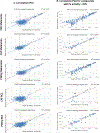Protocol for high throughput 3D drug screening of patient derived melanoma and renal cell carcinoma
- PMID: 38218316
- PMCID: PMC11542555
- DOI: 10.1016/j.slasd.2024.01.002
Protocol for high throughput 3D drug screening of patient derived melanoma and renal cell carcinoma
Abstract
High Throughput Screening (HTS) with 3D cell models is possible thanks to the recent progress and development in 3D cell culture technologies. Results from multiple studies have demonstrated different drug responses between 2D and 3D cell culture. It is now widely accepted that 3D cell models more accurately represent the physiologic conditions of tumors over 2D cell models. However, there is still a need for more accurate tests that are scalable and better imitate the complex conditions in living tissues. Here, we describe ultrahigh throughput 3D methods of drug response profiling in patient derived primary tumors including melanoma as well as renal cell carcinoma that were tested against the NCI oncologic set of FDA approved drugs. We also tested their autologous patient derived cancer associated fibroblasts, varied the in-vitro conditions using matrix vs matrix free methods and completed this in both 3D vs 2D rendered cancer cells. The result indicates a heterologous response to the drugs based on their genetic background, but not on their maintenance condition. Here, we present the methods and supporting results of the HTS efforts using these 3D of organoids derived from patients. This demonstrated the possibility of using patient derived 3D cells for HTS and expands on our screening capabilities for testing other types of cancer using clinically approved anti-cancer agents to find drugs for potential off label use.
Keywords: 3D cell models; HTS; Melanoma; Organoid; Patient derived organoids; Phenotypic; RCC; Renal carcinoma; Renal cell carcinoma; Scaffold free.
Copyright © 2024. Published by Elsevier Inc.
Conflict of interest statement
Declaration of competing interest The authors declared no potential conflict of interest with respect to the research, authorship and or publication of this article.
Figures






Similar articles
-
Organoid Models Established from Primary Tumors and Patient-Derived Xenograft Tumors Reflect Platinum Sensitivity of Ovarian Cancer Patients.bioRxiv [Preprint]. 2025 May 2:2024.06.28.601283. doi: 10.1101/2024.06.28.601283. bioRxiv. 2025. PMID: 40654830 Free PMC article. Preprint.
-
A rapid and systematic review of the clinical effectiveness and cost-effectiveness of paclitaxel, docetaxel, gemcitabine and vinorelbine in non-small-cell lung cancer.Health Technol Assess. 2001;5(32):1-195. doi: 10.3310/hta5320. Health Technol Assess. 2001. PMID: 12065068
-
The Black Book of Psychotropic Dosing and Monitoring.Psychopharmacol Bull. 2024 Jul 8;54(3):8-59. Psychopharmacol Bull. 2024. PMID: 38993656 Free PMC article. Review.
-
Systemic pharmacological treatments for chronic plaque psoriasis: a network meta-analysis.Cochrane Database Syst Rev. 2021 Apr 19;4(4):CD011535. doi: 10.1002/14651858.CD011535.pub4. Cochrane Database Syst Rev. 2021. Update in: Cochrane Database Syst Rev. 2022 May 23;5:CD011535. doi: 10.1002/14651858.CD011535.pub5. PMID: 33871055 Free PMC article. Updated.
-
Nivolumab for adults with Hodgkin's lymphoma (a rapid review using the software RobotReviewer).Cochrane Database Syst Rev. 2018 Jul 12;7(7):CD012556. doi: 10.1002/14651858.CD012556.pub2. Cochrane Database Syst Rev. 2018. PMID: 30001476 Free PMC article.
Cited by
-
A systematic review on the culture methods and applications of 3D tumoroids for cancer research and personalized medicine.Cell Oncol (Dordr). 2025 Feb;48(1):1-26. doi: 10.1007/s13402-024-00960-8. Epub 2024 May 28. Cell Oncol (Dordr). 2025. PMID: 38806997 Free PMC article.
-
Graph-Based 3-Dimensional Spatial Gene Neighborhood Networks of Single Cells in Gels and Tissues.BME Front. 2025 Mar 13;6:0110. doi: 10.34133/bmef.0110. eCollection 2025. BME Front. 2025. PMID: 40084126 Free PMC article.
-
Organoids as Sophisticated Tools for Renal Cancer Research: Extensive Applications and Promising Prospects.Cell Mol Bioeng. 2024 Oct 15;17(6):527-548. doi: 10.1007/s12195-024-00825-y. eCollection 2024 Dec. Cell Mol Bioeng. 2024. PMID: 39926385 Review.
References
Publication types
MeSH terms
Substances
Grants and funding
LinkOut - more resources
Full Text Sources
Medical

